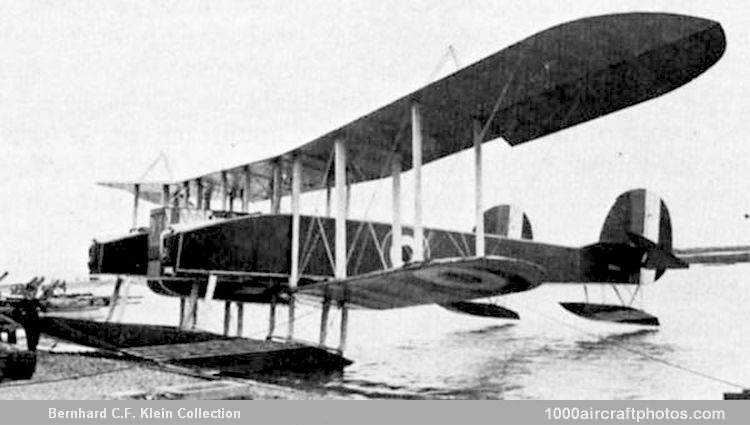08/31/2019. Remarks by Johan Visschedijk: "British experiments in dropping torpedoes from aircraft began in 1913, and had from their inception the blessing of Captain Murray F. Sueter (later Rear-Admiral Sir Murray Sueter, C.B.), the Director of the Air Department of the Admiralty.
In 1914, Harris Booth of the Air Department designed an enormous twin-float seaplane which was intended to be used as a bomber or torpedo-carrier. When it appeared it was the largest aircraft of any type which had been built in Britain. It was powered by three Sunbeam twelve-cylinder liquid-cooled V-engines, two of which were installed as tractor units at the forward ends of the twin fuselages. The third engine was mounted at the rear of the central control cabin (which was much too imposing a structure to be called a mere nacelle) and drove a pusher airscrew. All three engines had cowlings which were remarkably ugly and cumbersome.
The control cabin looked uncommonly like a domestic greenhouse, and was little better streamlined. The aircraft was to have had a crew of five. Armament consisted of three guns, or 22 100 lb (45 kg) bombs and one gun, or an 18 in (46 cm) Mk.VII long-range torpedo and a gun.
In 1915 the makers of the Wight seaplanes, the J. Samuel White and Co. Ltd. from Cowes, Isle of Wight, received an order for the construction of eight Admiralty A.D. Type 1 aircraft under Contract C.P. 01516/15, allotted the serials 1000 and 1355 to 1361. Due to the serial 1000 these aircraft are also referred to as the Type 1000 or A.D.1000. Due to the constructor, these aircraft are also referred to as Wight AD Type 1 Seaplane.
The first flight was made in the aircraft serialed 1358 by Squadron Commander J.W. Seddon, accompanied by Harris Booth, from Cowes on May 13, 1916. By January 1917, 1358's 310 hp engines had been replaced by 450 hp Sunbeam Viking 1 eighteen-cylinder liquid-cooled W-engines. Despite the increase in power, by February 20 all attempts by several pilots to get it into the air seemed to be unsuccessful. The Air Department recommended deletion of the aircraft and it was written off at Felixstowe on March 8, 1917. That day the second to fly, serialed 1000, was taken to the air, subsequently it was damaged. Five days later, March 13, the Air Department ended all further testing and on April 2 it was sent to RNAS Calshot for storage, where it was damaged beyond repair on December 28, 1917.
Of the remaining six aircraft, the 1359 was virtually completed but not assembled, the balance was not completed.
